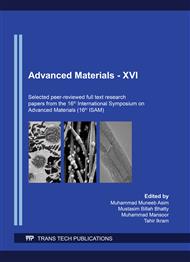[1]
A. Abdul, M. Rozainee, A. Johari, R. Alwi, Combustion studies of fluff refused-derived fuel (RDF) in fluidized bed (FB) system, Intl. J. Renew. Ener. Resour. 2 (2012) 23-26.
DOI: 10.1109/cet.2011.6041450
Google Scholar
[2]
S.Y. Ahn, S.Y. Eom, Y.H. Rhie, Y.M. Sung, C.E. Moon, G.M. Choi, D.J. Kim, Application of refuse fuels in a direct carbon fuel cell system, Ener. 51 (2013) 447-456.
DOI: 10.1016/j.energy.2012.12.025
Google Scholar
[3]
G. Beckers, Secondary fuels: Energy for the cement industry, World Cem. (2010) 135-138.
Google Scholar
[4]
Ö. Çepelioğullar, İ. Mutlu, S. Yaman, H. Haykiri-Acma, A study to predict pyrolytic behaviors of refuse-derived fuel (RDF): Artificial neural network application, J. Anal. Appl. Pyrolysis 122 (2016) 84-94.
DOI: 10.1016/j.jaap.2016.10.013
Google Scholar
[5]
V. Cozzani, L. Petarca, L. Tognotti, Devolatilization and pyrolysis of refuse derived fuels: characterization and kinetic modelling by a thermogravimetric and calorimetric approach, Fuel 74 (1995) 903-912.
DOI: 10.1016/0016-2361(94)00018-m
Google Scholar
[6]
M.K. Farooq, S. Kumar, An assessment of renewable energy potential for electricity generation in Pakistan, Renew. Sustain. Ener. Rev. 20 (2013) 240-254.
DOI: 10.1016/j.rser.2012.09.042
Google Scholar
[7]
A. Fernandez, J.O. Wendt, N. Wolski, K.R. Hein, S. Wang, M.L. Witten, Inhalation health effects of fine particles from the co-combustion of coal and refuse derived fuel, Chemosphere 51 (2003) 1129-1137.
DOI: 10.1016/s0045-6535(02)00720-8
Google Scholar
[8]
E. Ferrer, M. Aho, J. Silvennoinen, R.-V.Nurminen, Fluidized bed combustion of refuse-derived fuel in presence of protective coal ash, Fuel Process. Technol. 87 (2005) 33-44.
DOI: 10.1016/j.fuproc.2005.04.004
Google Scholar
[9]
A. Garg, R. Smith, D. Hill, N. Simms, S. Pollard, Wastes as Co-Fuels: The Policy Framework for Solid Recovered Fuel (SRF) in Europe, with UK Implications, Environ. Sci. Technol. 41 (2007) 4868-4874.
DOI: 10.1021/es062163e
Google Scholar
[10]
P. Grammelis, P. Basinas, A. Malliopoulou, G. Sakellaropoulos, Pyrolysis kinetics and combustion characteristics of waste recovered fuels, Fuel 88 (2009) 195-205.
DOI: 10.1016/j.fuel.2008.02.002
Google Scholar
[11]
S. Haydar, J. Masood, Evaluation of kitchen waste composting and its comparison with compost prepared from municipal solid waste, Pak. J. Eng. Appl. Sci. 8 (2016) 26-33.
Google Scholar
[12]
P. Khongkrapan, P. Thanompongchart, N. Tippayawong, T. Kiatsiriroat, Microwave plasma assisted pyrolysis of refuse derived fuels, Open Eng. 4 (2014) 72-79.
DOI: 10.2478/s13531-013-0142-5
Google Scholar
[13]
Y. Li, H. Wang, R. Li, Y. Chi, Thermogravimetric analysis on the combustion characteristics of refuse-derived fuel under an oxygen-enriched atmosphere, Biofuels 6 (2015) 217-222.
DOI: 10.1080/17597269.2015.1078562
Google Scholar
[14]
G. Piao, S. Aono, M. Kondoh, R. Yamazaki, S. Mori, Combustion test of refuse derived fuel in a fluidized bed, Waste Manage. 20 (2000) 443-447.
DOI: 10.1016/s0956-053x(00)00009-x
Google Scholar
[15]
D. Porshnov, V. Ozols, L. Ansone-Bertina, J. Burlakovs, M. Klavins, Thermal decomposition study of major refuse derived fuel components, Ener. Procedia 147 (2018) 48-53.
DOI: 10.1016/j.egypro.2018.07.032
Google Scholar
[16]
C. Qin, W. Tian, Y. Xiao, Study on the feasibility of RDF production from combustible components of MSW in China [J], Acta Scientiae Circum. 1 (2004) 023.
Google Scholar
[17]
J.-l. Su, L. Pan, C.-m.Zu, Research status and development of oxygen-enriched combustion technology [J], Ind. Boil. 3 (2008) 1-4.
Google Scholar
[18]
P. Šuhaj, J. Haydary, J. Husár, P. Steltenpohl, I. Šupa, Catalytic gasification of refuse-derived fuel in a two-stage laboratory scale pyrolysis/gasification unit with catalyst based on clay minerals, Waste Manage. 85 (2019) 1-10.
DOI: 10.1016/j.wasman.2018.11.047
Google Scholar
[19]
A. Valverde Salamanca, Thermal characterization of MSW for purpose of its gasification and pyrolysis, UniversitatPolitècnica de Catalunya, (2013).
Google Scholar
[20]
P. Vounatsos, M. Agraniotis, P. Grammelis, E. Kakaras, O. Skiadi, T. Zarmpoutis, Refuse-derived fuel classification in a mechanical–biological treatment plant and its valorization with techno-economic criteria, Int. J. Environ. Sci. Technol. 12 (2015) 1137-1146.
DOI: 10.1007/s13762-014-0509-z
Google Scholar
[21]
G. Wang, R. Silva, J. Azevedo, S. Martins-Dias, M. Costa, Evaluation of the combustion behaviour and ash characteristics of biomass waste derived fuels, pine and coal in a drop tube furnace, Fuel 117 (2014) 809-824.
DOI: 10.1016/j.fuel.2013.09.080
Google Scholar
[22]
L. X.-Yun, Z. R.-Dong, Q. J.-Guang, W. J.-Hu, Thermogravimetric investigation on co-combustion characteristics of coal gangue with municipal refuse derived fuel, DEStech Trans. Environ. Energy Earth Sci. (2016).
DOI: 10.12783/dteees/edep2016/5890
Google Scholar
[23]
L. Zhao, A. Giannis, W.-Y. Lam, S.-X. Lin, K. Yin, G.-A.Yuan, J.-Y.Wang, Characterization of Singapore RDF resources and analysis of their heating value, Sustainable Environ. Res. 26 (2016) 51-54.
DOI: 10.1016/j.serj.2015.09.003
Google Scholar


